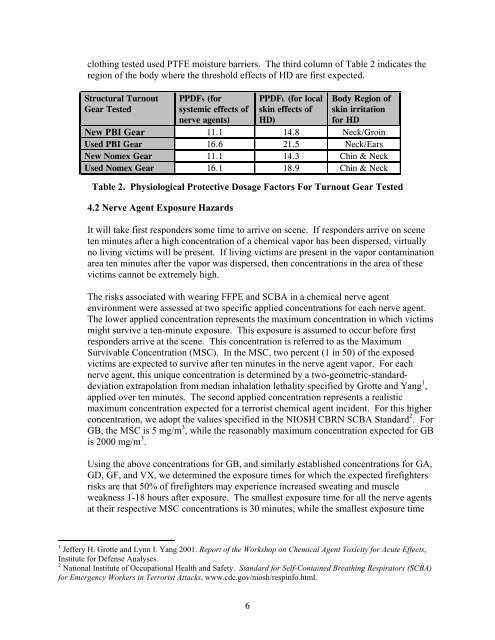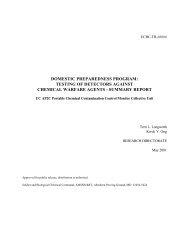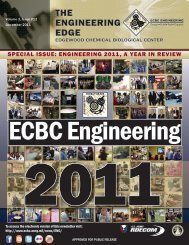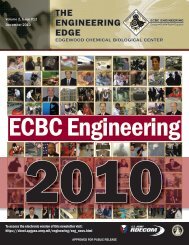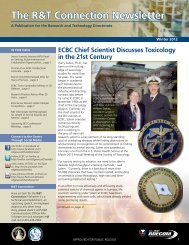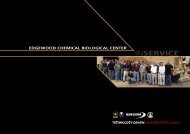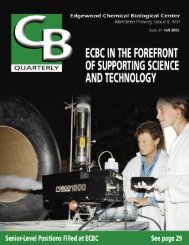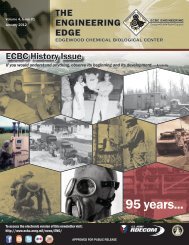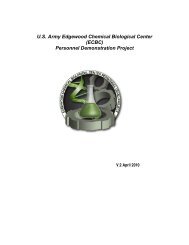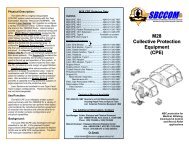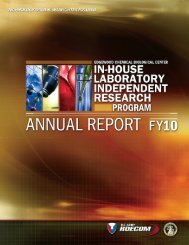(FFPE) with Self-Contained Breathing Apparatus (SCBA) for Rescue
(FFPE) with Self-Contained Breathing Apparatus (SCBA) for Rescue
(FFPE) with Self-Contained Breathing Apparatus (SCBA) for Rescue
You also want an ePaper? Increase the reach of your titles
YUMPU automatically turns print PDFs into web optimized ePapers that Google loves.
clothing tested used PTFE moisture barriers. The third column of Table 2 indicates the<br />
region of the body where the threshold effects of HD are first expected.<br />
Structural Turnout<br />
Gear Tested<br />
PPDFS (<strong>for</strong><br />
systemic effects of<br />
nerve a gents)<br />
PPDFL (<strong>for</strong> local<br />
skin effects of<br />
HD)<br />
Body Region of<br />
skin irritation<br />
<strong>for</strong> HD<br />
New PBI Gear 11.1 14.8 Neck/Groin<br />
Used PBI Gear 16.6 21.5 Neck/Ears<br />
New Nomex Gear 11.1 14.3 Chin & Neck<br />
Used Nomex Gear 16.1 18.9 Chin & Neck<br />
Table 2. Physiological Protective Dosage Factors For Turnout Gear Tested<br />
4.2 Nerve Agent Exposure Hazards<br />
It will take first responders some time to arrive on scene. If responders arrive on scene<br />
ten minutes after a high concentration of a chemical vapor has been dispersed, virtually<br />
no living victims will be present. If living victims are present in the vapor contamination<br />
area ten minutes after the vapor was dispersed, then concentrations in the area of these<br />
victims cannot be extremely high.<br />
The risks associated <strong>with</strong> wearing <strong>FFPE</strong> and <strong>SCBA</strong> in a chemical nerve agent<br />
environment were assessed at two specific applied concentrations <strong>for</strong> each nerve agent.<br />
The lower applied concentration represents the maximum concentration in which victims<br />
might survive a ten-minute exposure. This exposure is assumed to occur be<strong>for</strong>e first<br />
responders arrive at the scene. This concentration is referred to as the Maximum<br />
Survivable Concentration (MSC). In the MSC, two percent (1 in 50) of the exposed<br />
victims are expected to survive after ten minutes in the nerve agent vapor. For each<br />
nerve agent, this unique concentration is determined by a two-geometric-standarddeviation<br />
extrapolation from median inhalation lethality specified by Grotte and Yang 1 ,<br />
applied over ten minutes. The second applied concentration represents a realistic<br />
maximum concentration expected <strong>for</strong> a terrorist chemical agent incident. For this higher<br />
2<br />
concentration, we adopt the values specified in the NIOSH CBRN <strong>SCBA</strong> Standard . For<br />
GB, the MSC is 5 mg/m 3 , while the reasonably maximum concentration expected <strong>for</strong> GB<br />
is 2000 mg/m 3 .<br />
Using the above concentrations <strong>for</strong> GB, and similarly established concentrations <strong>for</strong> GA,<br />
GD, GF, and VX, we determined the exposure times <strong>for</strong> which the expected firefighters<br />
risks are that 50% of firefighters may experience increased sweating and muscle<br />
weakness 1-18 hours after exposure. The smallest exposure time <strong>for</strong> all the nerve agents<br />
at their respective MSC concentrations is 30 minutes, while the smallest exposure time<br />
1 Jeffery H. Grotte and Lynn I. Yang 2001. Report of the Workshop on Chemical Agent Toxicity <strong>for</strong> Acute Effects,<br />
Institute <strong>for</strong> Defense Analyses.<br />
2 National Institute of Occupational Health and Safety. Standard <strong>for</strong> <strong>Self</strong>-<strong>Contained</strong> <strong>Breathing</strong> Respirators (<strong>SCBA</strong>)<br />
<strong>for</strong> Emergency Workers in Terrorist Attacks, www.cdc.gov/niosh/respinfo.html.<br />
6


